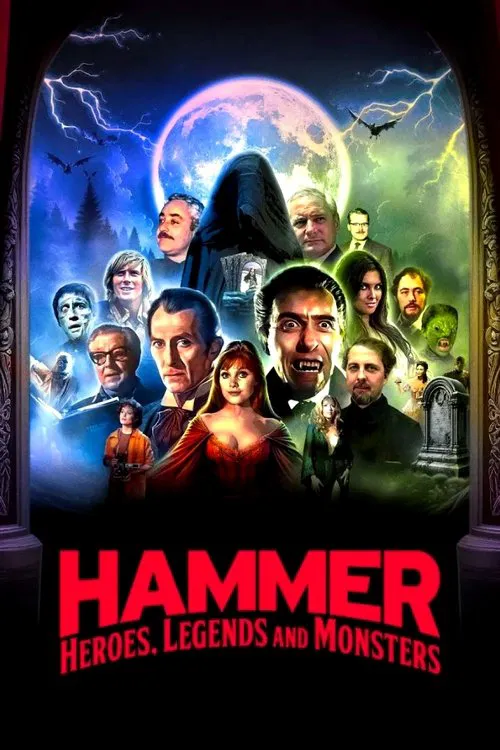Hammer: Heroes, Legends and Monsters

Plot
The documentary Hammer: Heroes, Legends and Monsters delves into the fascinating history of the renowned British production company, Hammer Productions. Founded in 1934 by comedian and entrepreneur William Hinds, also known as Will Hammer, the company's journey from its humble beginnings in a London back office to its iconic status within the horror film genre is a captivating tale of innovation, perseverance, and creative genius. In the early years, Hammer Productions primarily focused on producing low-budget films, including comedies and dramas. However, with the onset of World War II, the company's operations were severely impacted, and it was forced to diversify its portfolio. After the war, Hammer's fortunes began to change, and the company started to explore the world of horror cinema. It was a bold move that would prove to be a defining moment in Hammer's history. One of the key factors that contributed to Hammer's success in the horror genre was its ability to create a unique and recognizable style. The company's films often featured atmospheric sets, elaborate costumes, and makeup, as well as a distinct blend of sex, suspense, and gore. This approach not only captivated audiences but also set Hammer apart from its competitors. The studio's breakthrough film, The Curse of Frankenstein (1957), directed by Terence Fisher, marked a significant milestone in Hammer's evolution. Starring Peter Cushing as the iconic Baron Victor Frankenstein, the film's blend of horror, drama, and romance captivated audiences and helped establish Hammer as a major player in the horror industry. The film's success was largely due to its ability to strike a balance between art and commerce, appealing to both highbrow critics and popular audiences. The 1957 film Dracula, also directed by Terence Fisher, solidified Hammer's reputation as a master of the horror genre. Starring Christopher Lee in the title role, the film's portrayal of the vampire Count Dracula was a defining moment in Hammer's history. Lee's charismatic performance and the film's atmospheric setting helped create a sense of foreboding and dread that became synonymous with Hammer productions. Throughout the 1950s and 1960s, Hammer continued to produce a string of successful horror films, including The Quatermass Xperiment (1955), The Mummy (1959), and Brides of Blood (1962). These films not only cemented Hammer's status as a leading horror studio but also helped launch the careers of its most iconic stars, including Christopher Lee and Peter Cushing. Lee and Cushing, who became two of Hammer's most beloved stars, frequently appeared together in the studio's films. Their on-screen partnership, which spanned over a decade, helped establish Hammer as a hub for creative storytelling and talent development. Their collaborations, including The Curse of Frankenstein, Dracula, and The Hound of the Baskervilles (1959), remain some of Hammer's most cherished and enduring classics. Hammer's success also attracted a talented team of writers, including Richard Matheson, Don Sharp, and Anthony Hinds (son of William Hinds). These writers contributed to some of Hammer's most memorable films, including Matheson's adaptation of The Reptile (1966) and Sharp's direction of The Lost Continent (1967). Throughout its rise to prominence, Hammer's creative vision was consistently guided by the studio's founder, William Hinds, and later by his son, Anthony Hinds. The company's leadership played a crucial role in nurturing talent and encouraging innovation, which ultimately helped Hammer establish its unique identity within the horror genre. However, Hammer's peak years were not without challenges. The studio faced stiff competition from other British production companies, such as Rank and Pinewood, which produced high-quality films with more substantial budgets. Hammer's low-budget approach, while innovative, often limited the scope of its productions, leading to a perception that the studio's films were inferior to those of its competitors. Despite these challenges, Hammer's legacy has endured, and the company's influence can be seen in many modern horror films. The studio's commitment to creating innovative and atmospheric horror films has inspired countless filmmakers, including Wes Craven, Dario Argento, and Neil Jordan. Hammer: Heroes, Legends and Monsters is a loving tribute to a bygone era in cinema history. The documentary celebrates Hammer's incredible journey from a small back office in Regent Street to its iconic status within the horror genre. Through a wealth of archival footage and interviews with industry experts, the film provides a fascinating insight into the studio's creative process and the people who brought its most beloved films to life. As the documentary draws to a close, it becomes clear that Hammer's impact goes far beyond its impressive filmography. The company's influence on popular culture, its legacy in the horror genre, and its enduring appeal to audiences worldwide make it a beloved and integral part of our cinematic heritage. Hammer: Heroes, Legends and Monsters is a must-see for horror fans and film enthusiasts alike, offering a unique glimpse into a golden age of cinema that continues to captivate audiences to this day.
Reviews
Recommendations



